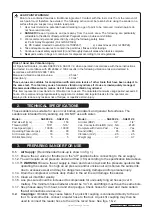
Model: . . . . . . . . . . . . . . SA800.V4 . . .SA801.V4
Pad size Ø (mm) . . . . . . . . . . . 150 . . . . . . . . 150
Thread (UNF) . . . . . . . . . . . . 5/16” . . . . . . . 5/16”
Free Speed (rpm) . . . . . . . . 10000 . . . . . . 10000
Operating Pressure (psi) . . . . . . 90 . . . . . . . . . 90
Air Consumption (cfm). . . . . . . . 16 . . . . . . . . . 16
Orbital Size (mm) . . . . . . . . . . . . 5 . . . . . . . . . . 5
Model: . . . . . . . . . . . . . . SA800.V4 . . .SA801.V4
Air Inlet (BSP) . . . . . . . . . . . . . 1/4” . . . . . . . . 1/4”
Vac. Connector Bore/OD (mm) . NA . . . . . . . Ø 28
Complete with Velcro Pad . . . . .Yes . . . . . . . . Yes
Sound (dBA) . . . . . . . . . . . . . . . 85 . . . . . . . . . 85
Vibration (m/s²) . . . . . . . . . . . . . 2.5 . . . . . . . . 2.5
Weight (kg) . . . . . . . . . . . . . . . . 0.7 . . . . . . . . 0.7
2.
TECHNICAL SPECIFICATIONS
3.1. Air Supply:
(Recommended hook-up is shown in fig. 1.)
3.1.1. Ensure the air valve (or throttle) is in the "off" position before connecting to the air supply.
3.1.2. You will require an air pressure and an air flow (cfm) according to the specification listed above.
3.1.3.
WARNING!
Ensure the air supply is clean and does not exceed the pressure quoted while
operating the sander. Too high an air pressure and/or unclean air will shorten the sander life
due to excessive wear and may be dangerous causing damage and/or personal injury.
3.1.4. Drain the compressor air tank daily. Water in the air line will damage the sander.
3.1.5. Clean air inlet filter weekly.
3.1.6. Line pressure should be increased to compensate for unusually long air hoses (over 8
metres). The minimum hose diameter should be 1/4” I.D. and fittings must have the same bore.
3.1.7. Keep hoses away from heat, oil and sharp edges. Check hoses for wear and make certain
that all connections are secure.
3.2. Couplings:
Vibration may cause failure if a quick fit coupling is connected directly to the air
tool. To overcome this, connect a leader hose to the tool. A quick fit coupling may then be
used to connect the leader hose to the air line recoil hose. See figs. 1 & 2.
These sanders are suitable for use on car bodies, woodwork and general flat surfaces. The
sanders are intended for dry sanding only. DO NOT use with water.
3.
PREPARING SANDER FOR USE
LEAD PAINT WARNING!
Paint once contained lead as a traditional ingredient. Contact with the toxic dust from the removal of
such paint must therefore be avoided. The following action must be taken before using the sander on a
surface that you suspect may contain lead paint.
1. User must determine potential hazard relating to age of paint to be removed (modern paints do
not have lead content).
2.
DANGER!
Keep all persons and pets away from the work area. The following are particularly
vulnerable to the effects of lead paint dust:
Pregnant women, babies and children.
3. We recommend personal protection by using the following safety items:
a
) Paint Spray Respirator (Our ref SSP1699)
b
) PE Coated Hooded Coverall (Our ref SSP267).
c
) Latex Gloves (Our ref SSP24).
4. Take adequate measures to contain the paint dust, flakes and scrapings.
5. Continue to wear safety equipment (3) and thoroughly clean all areas when task is complete.
6.
Seal
paint waste in bags or containers for disposal according to local regulations.
Risk of Hand Arm Vibration Injury
Air Operated Sanders, models SA800.V2 & SA801.V2, when operated in accordance with these instructions
and tested in accordance with EN 28662-2: 1994 results in the following vibration emission declared in
accordance with BS EN12096: 1996.
Measured vibration emission value: . . . . . . . . . . .2.5m/s²
Uncertainty: . . . . . . . . . . . . . . . . . . . . . . . . . . . . . .1.0m/s²
These values are suitable for comparison with emission levels of other tools that have been subject to
the same test. This tool may cause hand-arm vibration syndrome if its use is inadequately managed.
Recommended Measures to reduce risk of hand-arm vibration syndrome:
This item represents a low Hand Arm Vibration risk to users. The calculated minimum usage period exceeds 8
hours. We recommend appropriate safety equipment is utilised and regular breaks for the operator are
employed to reduce any residual risk of fatigue or repetitive strain injury.
Original Language Version
SA800.V4, SA801.V4 Issue: 1 - 15/11/10





















